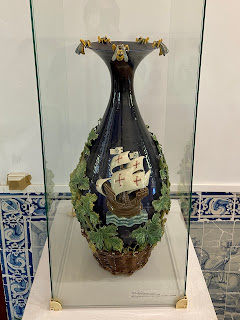The last day of the road trip hits us with relief and regret. We open the windows, enjoy the foggy morning air by the muddy river, and pack our cases. As we zip them closed, we process the images and stories we've collected this week.
Our rest stop is Caldas da Rainha (pop. 51,729 in 2011). It's a city where we've stopped before, but not long enough to figure things out. There's a free lot near the Parque Dom Carlos I where we safely stash the rental car. Lunch is near the Praça da Republica.
This Sunday morning in Caldas is bright and busy. The mercado in the Praça is just winding down, and the people migrate to the Parque to enjoy the black swans, the flowering vines, and the delicious weather.
After lunch, we take refuge from the crowds in the Museu da Cerâmica. Before we enter, there is an image at the back gate, of wild cats attacking riders, and a warning:
De aquele q não admiraJa' nada de bom se tira.Pois quem não sabe admirarNão sabe amar.(Afonso Lopes Viera, 1878-1946)[From the one that doesn't admireNothing good is taken away.Because those who don't know how to admireDon't know how to love.]
The Museu is in the Quinta Visconde de Sacavém (late nineteenth century). The house sits in a wonderful park of its own, filled with old shade trees, flower beds, and a tile-encrusted fountains. The Visconde's reply to Lopes Viera is by the front door:
Tristezas conheço-as bemTenho-as de noite e de diaRapazes haja alegriaNa Quinta do Sacavém[Sorrows I know them wellI have them night and dayGuys, let there be joyAt Quinta do Sacavém]
Inside, doorways with ornate encasements lead to rooms with tile wainscot – a blue and white sampler of captivating vignettes. The ceramic displays on the ground floor include European and Portuguese pieces from the seventeenth and eighteenth centuries. The larger room on the right (north) features work from the Real Fábrica do Rato (in the Largo do Rato in Lisbon, seventeenth century), highlighted by the corner fireplace.
For us, the excitement is all about the door frames.
Upstairs, the ceramics dazzle. On the stair landing, Rafael Bordalo Pinheiro's frogs greet us; the tiles we've seen, but the basin (bird bath?) is phenomenal and novel. To the right, the 'Caldas' ceramics begin with intricate figurines and comical characters. Soon we are amongst moneys, snakes, chickens, and dragons.
Several unique pieces stand out. "Jarra. Tipo Foz" is an over-scale vase with a caravel by Manuel Gustavo Bordalo Pinheiro (1908, Rafael's son). "Papeleira de Suspensão. Orelha" is a surrealist desk organizer by Rafael Bordalo Pinheiro (c1884-1905), with the slogan: "Les murs ont des oreilles" (the walls have ears, in French). "Escultura Cerâmica. Catedral de Colónia" is a room-filling model of the Cologne Cathedral by José da Silva Pedro (Sacavém, 1950)
We encounter the "Orelha" (ear) again during a visit to the Loja da Fábrica Bordallo Pinheiro, an 'updated' left ear version with an AirPod. The phrase is modified, too: "As parades te em ouvidos" (the stops in your ears). Interestingly, the computer translator tells me if "parades te em" is changed to "paredes têm", it says "the walls have ears" - a play on words.
Note: the factory and store use the older Portuguese orthography's "Bordallo" spelling, but the museums use the newer "Bordalo".
We move on to the Museu de José Malhoa, set in the Parque Dom Carlos. The Casa-Museum in our own neighborhood features many of his portraits, so introductions have been made. This Museu features the work of Malhoa, along with his friends and contemporaries known as "O Grupo do Leão" (1881-89), who promoted the Naturalismo art movement (early Impressionism; Manet not Monet). Of those images, the one that catches the spirit of our trip is "Paul da Outra Banda" (Malhoa, 1883). a landscape of the marshes, with the sun on the horizon, seabirds, and a decomposing boat.
Rafael Bordalo Pinheiro also features as a "Leão", and the Museu contains his "Paixão de Cristo" (1887-99). This is a monumental group of over sixty near-life-size figures, dramatic and dark. The project is thematically removed from the frogs and flowers, or the derisive caricatures that we've seen, and might be right at home in a church like Válega.
The central-east gallery offers some of the largest paintings, as if we are sharing the room and the "O Último Interrogatório do Marquêz de Pombal" with the man himself.
Then, in the next gallery, we are spying narrow streetscapes and intimate portraits, sketchbook studies in color and light – all familiar Portuguese scenes from our journeys.
Sculptures of the "Estado Novo" in the central-west gallery conclude our viewing. Colossal plaster cast studies of the king and queen dominate the exhibit (Dom Dinis, 1943, and Rainha Dona Leonor, 1935, by Francisco Franco de Sousa), However, the features and expressions of the busts and figures arrayed nearby leave an enduring impression – thoughtful and educated, important people of their day, contemplating the values of art, history, and their 'new nation'.




















































